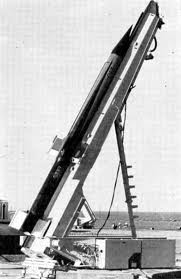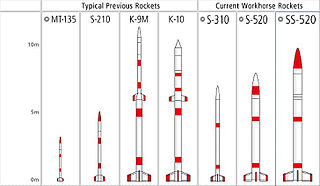
A rocket is a vehicle that uses jet propulsion to accelerate without using the surrounding air. A rocket engine produces thrust by reaction to exhaust expelled at high speed. Rocket engines work entirely from propellant carried within the vehicle; therefore a rocket can fly in the vacuum of space. Rockets work more efficiently in a vacuum and incur a loss of thrust due to the opposing pressure of the atmosphere.

A sounding rocket or rocketsonde, sometimes called a research rocket or a suborbital rocket, is an instrument-carrying rocket designed to take measurements and perform scientific experiments during its sub-orbital flight. The rockets are used to launch instruments from 48 to 145 km above the surface of the Earth, the altitude generally between weather balloons and satellites; the maximum altitude for balloons is about 40 km and the minimum for satellites is approximately 121 km. Certain sounding rockets have an apogee between 1,000 and 1,500 km, such as the Black Brant X and XII, which is the maximum apogee of their class. Sounding rockets often use military surplus rocket motors. NASA routinely flies the Terrier Mk 70 boosted Improved Orion, lifting 270–450-kg (600–1,000-pound) payloads into the exoatmospheric region between 97 and 201 km.

Orión was the designation of a sounding rocket of Argentina, which was launched between 1965 and 1971 at CELPA, Mar Chiquita, Tartagal and Wallops Island.

The Dragon is a two-stage French solid propellant sounding rocket used for high altitude research between 1962 and 1973. It belonged thereby to a family of solid-propellant rockets derived from the Bélier, including the Centaure, the Dauphin and the Éridan.
Cora was a French experimental rocket. It was the largest rocket ever launched in Western Europe. It was primarily used for testing the second (Coralie) and third stages (Astris) of the multinational Europa Rocket, which was developed and produced by the European Launcher Development Organisation, the predecessor to the present day European Space Agency.

Centaure was a two-stage French sounding rocket consisting of a Venus first stage and a Belier second stage. It belongs to a family of solid-propellant rockets consisting of the Belier, Centaure, Dragon, Dauphin, and Eridan.
The INTA-255 was a Spanish sounding rocket. The INTA-255 was launched with 4 Chick rockets, which start with 0.2 seconds long burned. The apogee of INTA-255 amounted to 150 km, the takeoff thrust 42.00 kN, the gross mass 340 kg, the diameter 0.26 m and the length to 6,03 m.

Rigel is an Argentinian sounding rocket. The double stage Rigel was launched seven times between 1969 and 1973. The Rigel rocket has a maximum altitude of 310 km, a launch mass of 300 kg, a diameter of 0.228 metres and a length of 6.30 metres.

S-Series is a fleet of sounding rockets funded by the Japan Aerospace Exploration Agency (JAXA) that have been in service since the late 1960s. Manufactured by IHI Aerospace and operated by the Institute of Space and Astronautical Science (ISAS). The nomenclature of the S-Series rockets is the number of "S"s indicates the number of stages, and the following number details the diameter of the craft in millimeters. For example, the S-310 is a single stage rocket with a diameter of 310 mm.
The SpaceLoft XL is a sounding rocket developed by private spaceflight company UP Aerospace. The rocket is capable of lofting a 79 lb (36 kg) payload to a sub-orbital trajectory with an apogee of about 71.5 miles (115 km). It travels for approximately 60 seconds to cross the Kármán line. All launches are sub-orbital and do not complete one orbital revolution. Launches are conducted from the company launch facility at Spaceport America in Upham, New Mexico.

VSB-30 - "Veículo de Sondagem Booster – 30" or "Foguete Suborbital VSB-30" is the designation of a Brazilian sounding rocket, which replaced the Skylark rocket at Esrange.

In 1955, both the United States and the Soviet Union (USSR) announced plans for launching the world's first satellites during the International Geophysical Year (IGY) of 1957–58. Project Vanguard, proposed by the US Navy, won out over the US Army's Project Orbiter as the satellite and rocket design to be flown in the IGY. Development of Intercontinental Ballistic Missiles, the Atlas by the US and the R-7 by the USSR, accelerated, entering the design and construction phase.

The Safir was the first Iranian expendable launch vehicle able to place a satellite in orbit. The first successful orbital launch using the Safir launch system took place on 2 February 2009 when a Safir carrier rocket placed the Omid satellite into an orbit with a 245.2 km (152.4 mi) apogee. Making Iran the ninth nation capable of producing and launching a satellite.
A number of suborbital spaceflights were conducted during 2008. These consist mostly of sounding rocket missions and missile tests, and include other flights such as an ASAT firing. Between the start of the year and 16 July, at least 43 publicly announced suborbital spaceflights were conducted, the first of them on 11 January.
The VS-30 is a Brazilian sounding rocket, derived from the Sonda 3 sounding rocket's first stage. It consists of a single, solid-fuelled stage, and has been launched from Alcântara, Maranhão, and Parnamirim, Rio Grande do Norte, in Brazil, and Andøya in Norway.

The NOTS-EV-2 Caleb, also known as NOTS-500, Hi-Hoe and SIP was an expendable launch system, which was later used as a sounding rocket and prototype anti-satellite weapon. It was developed by the United States Navy's Naval Ordnance Test Station (NOTS) as a follow-up to the NOTS-EV-1 Pilot, which had been abandoned following ten launches officially classified as failed missions. Two were launched in July and October 1960, before the cancellation of the project. Following cancellation, two leftover Calebs were used in the Satellite Interceptor Program (SIP), while three more were used as sounding rockets, under the designation Hi-Hoe. These derivatives flew until July 1962, when the Hi-Hoe made its final flight.

Rohini is a series of sounding rockets developed by the Indian Space Research Organisation (ISRO) for meteorological and atmospheric study. These sounding rockets are capable of carrying payloads of 2 to 200 kilograms between altitudes of 100 to 500 kilometres. The ISRO currently uses RH-200, RH-300, RH-300 Mk-II, RH-560 Mk-II and RH-560 Mk-III rockets, which are launched from the Thumba Equatorial Rocket Launching Station (TERLS) in Thumba and the Satish Dhawan Space Center in Sriharikota.
Tronador is a series of Argentine rockets, including the Tronador I and Tronador II vehicles, to develop a liquid-propellant rocket expendable launch system called ISCUL.
INSAT-4B was an Indian communications satellite which forms part of the Indian National Satellite System. Launched in 2007, it was placed in geostationary orbit at a longitude of 93.48° East.

The Castor A was an Argentine sounding rocket designed in 1969 by the Instituto de Investigaciones Aeronáuticas y Espaciales (IIAE).













